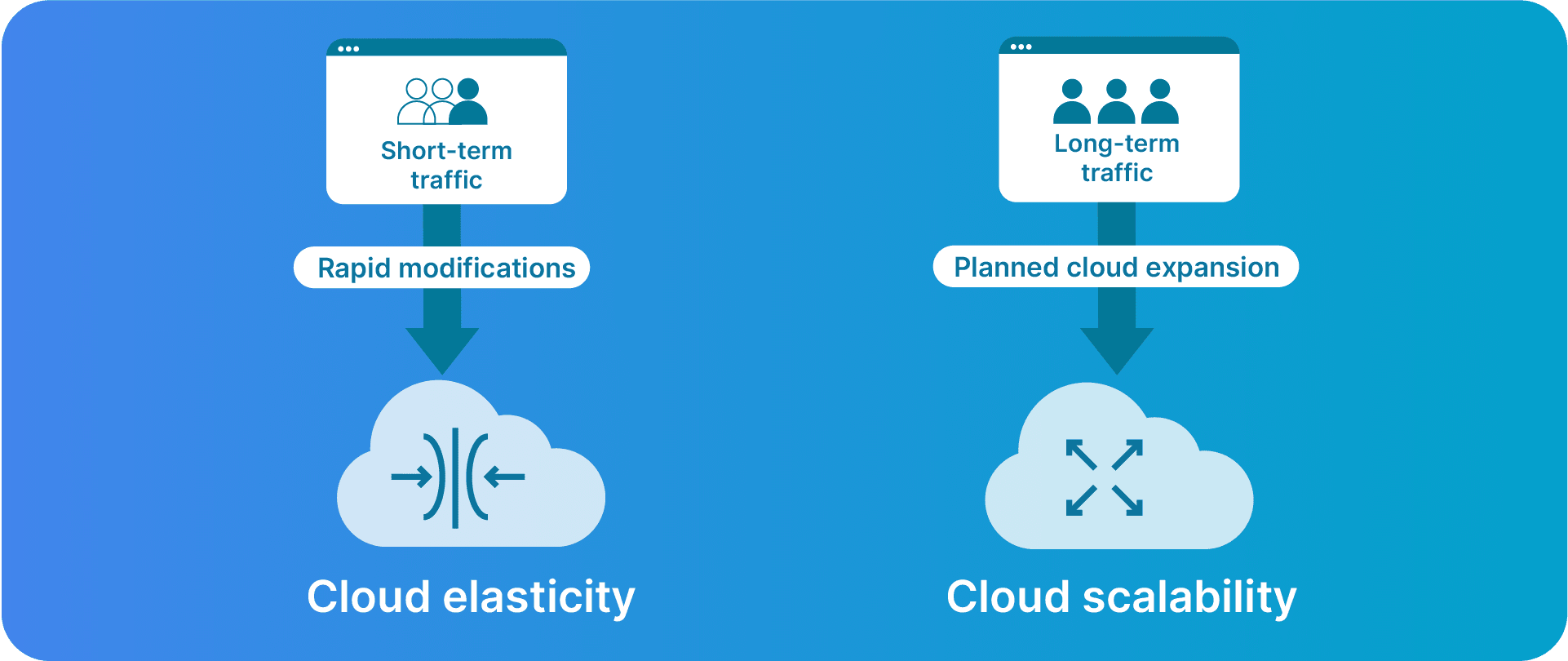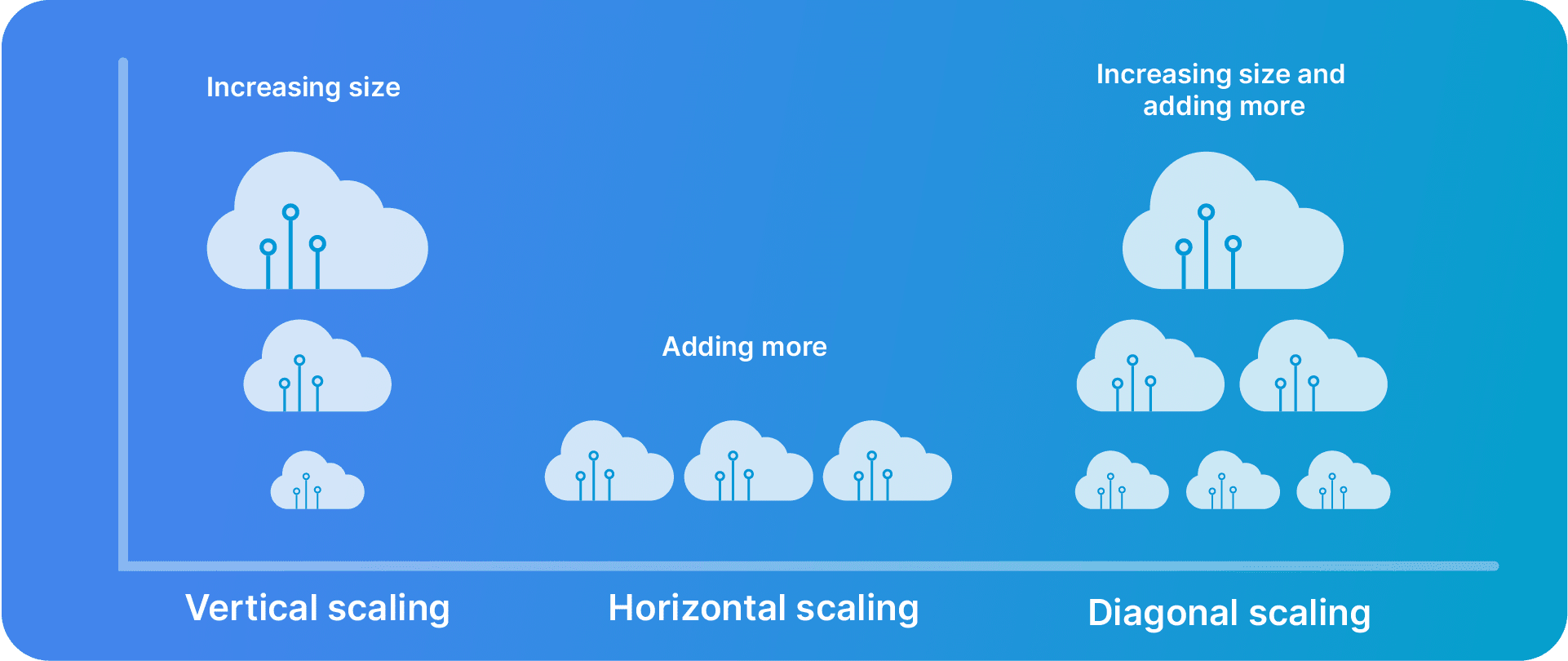The importance of elasticity in cloud computing
Key points
- Cloud elasticity refers to the ability of a cloud computing system to dynamically allocate and deallocate computing resources based on demand. Essentially, it means that resources, such as virtual machines, storage, or network bandwidth, can automatically scale up or down in response to changes in workload or user demand.
- Cloud elasticity ensures businesses can handle spikes in demand, like Black Friday sales for eCommerce sites or viral content for media outlets, without compromising performance.
- By efficiently utilizing resources, cloud elasticity supports a greener, more sustainable approach to cloud computing, reducing the environmental impact of IT operations. Liquid Web offers Cloud Dedicated Servers and VMware Private Cloud solutions that provide both elasticity and scalability to businesses looking to optimize their cloud infrastructure.
Cloud computing has become important for modern business operations. In this cloud-centric world, cloud elasticity thrives as a concept that's revolutionizing the way we manage and utilize cloud infrastructure. This dynamic capability allows businesses to adjust their cloud resources easily, scaling up or down to perfectly match their demands.
Whether you're a small startup or a global enterprise, understanding and implementing cloud elasticity can significantly optimize your operations. This can ensure you're not just keeping pace with the digital transformation but leading the charge.
This guide is your comprehensive journey into the world of cloud elasticity. It’ll tackle the challenges head-on, providing practical solutions and actionable steps to achieve and optimize cloud elasticity in your operations.
What is cloud elasticity?
Cloud elasticity allows a cloud environment to adjust resource provisioning (CPU, memory, storage, etc.) in response to changing demand levels. This means cloud infrastructure can grow or shrink in capacity, ensuring the right amount of resources at the right time.
The concept of cloud elasticity is a departure from traditional computing models, which often rely on static resources. In the past, businesses had to predict their maximum resource needs and purchase accordingly, leading to either wasteful overspending or detrimental shortages during peak times. Cloud elasticity brings a dynamic solution to this problem, offering a flexible and efficient way to use cloud services.”
— Ken Wallace, VMware Product Manager at Liquid Web.
Cloud elasticity can be automatic or manual, giving organizations control based on their preferences or their cloud service provider's capabilities. Monitoring tools enable dynamic resource adjustments, ensuring efficient allocation and responsiveness to business needs. This ensures that resources are not just allocated efficiently but are also responsive to the actual needs of the business.
One of the most appealing aspects of cloud elasticity is its non-disruptive nature. When resources are adjusted, they are reallocated from underutilized areas, ensuring that there's no negative impact on ongoing operations. This scaling is particularly advantageous in public cloud setups, where resources are abundant and can be reallocated with ease.
Being termed as an “elastic” cloud provider indicates the provider's prowess in autonomously provisioning and de-provisioning resources based on usage demands. This aligns perfectly with a pay-as-you-go model, making cloud elasticity not just a technical feature but a financial benefit.
What are the benefits of cloud elasticity?
Cost savings and enhanced Return on Investment (ROI)
By aligning costs directly with real-time demand, businesses only pay for the resources they use. This prevents over-provisioning and ensures efficient use of financial resources. Such cost-efficiency is essential in today’s competitive landscape, where maximizing every dollar counts.
Optimal performance during peak times
Elasticity ensures that cloud environments are always primed for optimal performance, even during unexpected surges in demand. Consider an eCommerce website during a flash sale; cloud elasticity can automatically provision additional resources to handle the increased traffic, ensuring smooth and uninterrupted service to customers. This agility and responsiveness make an elastic cloud a cornerstone of modern, user-centric digital services.
Efficient resource usage
By dynamically adjusting resources, cloud elasticity promotes a greener, more sustainable approach to cloud computing. It significantly reduces the waste of computing resources, leading to not just cost savings but also a smaller carbon footprint. This efficiency resonates well with the growing emphasis on sustainability in business operations.
Automation frees up human resources
Automated cloud elasticity mechanisms free IT staff from the constant monitoring of resource usage. This allows them to concentrate on more strategic initiatives that can drive business growth and innovation instead.
Encouraging innovation
The flexibility offered by cloud elasticity encourages businesses to experiment and innovate without the fear of hitting resource limits. This freedom to explore new ideas can significantly speed up the development and deployment of new products and services.
However, embracing cloud elasticity also presents certain challenges that organizations must navigate.
Challenges of cloud elasticity
- Elastic provisioning time: For businesses with steady, predictable demand, the slight delay in provisioning that can accompany elasticity may not offer much of an advantage over a static cloud setup designed to cover expected usage.
- Technical complexities: Managing a highly elastic cloud environment introduces complexities, especially in monitoring and controlling resource provisioning to ensure efficiency and performance.
- Cost visibility and predictability: The pay-per-use model, while advantageous for aligning costs with actual usage, can lead to unpredictable expenses, especially during periods of unexpectedly high demand.
- Security considerations: Scaling resources dynamically can complicate security management, particularly if compromised servers are inadvertently brought online or dropped from the network.
- Resource competition: In a multi-tenant cloud environment, there's potential for competition over resources, although reputable providers often have measures in place to prevent this and ensure reliable resource availability.
Despite these obstacles, with careful planning, the right tools, and a reputable cloud provider such as Liquid Web, businesses can leverage cloud elasticity effectively to enhance their operations while mitigating potential drawbacks.
How does cloud elasticity work?
In cloud computing, physical server resources are abstracted and presented as virtual services. This means that resources like CPU power, memory, and storage are not tied to a specific hardware device. Instead, they can be allocated from a pool of resources. This virtual infrastructure enables resources to be easily shifted between users within a cloud or even between different clouds, providing flexibility that is not possible in traditional physical server setups.
A cloud environment will automatically adjust resources in response to fluctuating demand. This automatic scaling is crucial for maintaining optimal performance and cost efficiency. For example, during times of high demand, additional resources are seamlessly provisioned to handle the load, and similarly, resources are scaled down when demand decreases.
The technical pprocess behind this involves monitoring tools and algorithms that continually assess the need for resources based on current usage patterns. When a threshold is crossed, the system automatically initiates the provisioning or de-provisioning of resources, ensuring that the cloud environment is always right-sized for the current demand.”
— Ken Wallace, VMware Product Manager at Liquid Web.
Cloud environments typically offer both manual and auto-scaling options. Manual scaling allows administrators to adjust resources based on anticipated needs. Auto-scaling, on the other hand, happens in real time based on actual usage. This combination of capabilities ensures that businesses can maintain control over their cloud resources while benefiting from the agility and efficiency of automatic scaling.
Also, cloud elasticity supports a pay-per-use model, meaning that costs directly correlate with the amount of resources consumed. This model ensures businesses are not paying for idle capacity, making cloud computing more cost-effective. Automation plays a crucial role in managing this elasticity. It allows for the dynamic adjustment of resources without the need for constant human intervention.
Cloud elasticity typical use cases
To illustrate the practical benefits of cloud elasticity, let's explore some real-world examples:
- eCommerce site during Black Friday: For an eCommerce website experiencing a massive surge in traffic during Black Friday sales, cloud elasticity will allow for automatic scaling up of resources to handle the increased load, ensuring a smooth shopping experience for customers.
- Viral news website: If a news website suddenly goes viral due to a breaking news event, cloud elasticity quickly provisions additional resources to cope with the spike in traffic, maintaining website performance and availability.
- Temporary projects: For short-term projects like data analytics or annual IT training, cloud elasticity provides the necessary resources on demand, scaling back down once the project is complete and optimizing both performance and cost.
- Businesses with fluctuating demand: Streaming services like Netflix may see spikes in demand with the release of popular shows. Cloud elasticity ensures these spikes can be accommodated seamlessly, providing a consistent streaming experience.
These cases highlight how cloud elasticity eliminates the need for manual intervention and optimizes both performance and costs.
Cloud elasticity vs cloud scalability
While cloud elasticity and scalability may seem similar, they serve different purposes. Cloud scalability refers to the planned, permanent adjustment of resources to accommodate growth without compromising performance or cost-effectiveness. Unlike elasticity, which is reactive and temporary, scalability is about proactive and fixed changes to resource allocation.

Cloud scalability can be vertical (adding more resources to a single server), horizontal (adding more servers), or diagonal (both). Both concepts aim to adjust resources efficiently. But elasticity is about rapid, automatic adjustments to short-term fluctuations, whereas scalability focuses on long-term growth and capacity planning.

Achieving and optimizing elasticity in cloud computing: A step-by-step guide
If you're considering making the leap towards a more elastic cloud environment, here’s an overview of how you can start:
Step 1: Assess your current infrastructure
Before diving into cloud elasticity or scalability, take a comprehensive look at your existing IT infrastructure. Understand the resources you currently have, how you're utilizing them, and where there might be gaps or overprovisions. Identifying bottlenecks or performance issues is essential at this stage.
This assessment will help determine whether moving towards an elastic or scalable cloud model is the right move. It will also tell you where this move could have the most impact.
Step 2: Set clear objectives
Having a clear set of goals is essential for any strategic IT decision. With cloud elasticity or scalability, define what you’re aiming to achieve. Are you looking to handle spikes in user traffic more effectively, accommodate seasonal business fluctuations, or improve overall system reliability and performance?
Decide whether your goals are more aligned with the temporary, demand-driven nature of elasticity or the long-term growth focus of scalability.
Step 3: Choose the right cloud scalability model
Selecting the appropriate model for cloud scalability involves carefully evaluating your business needs. Consider your anticipated growth, budget, application architecture, and how much control you wish to maintain over your cloud environment. Speaking directly with cloud providers can offer invaluable insights into which services and models will best support your objectives.
Step 4: Monitor performance
Once you've implemented cloud elasticity or scalability solutions, continuous monitoring becomes key to ensuring optimal performance. Employ monitoring tools to keep an eye on how you utilize resources and identify any new bottlenecks or inefficiencies.
Many cloud providers offer performance monitoring tools and services designed to help you maintain the efficiency of your cloud environment. Regularly reviewing and adjusting your resource allocation will help you stay aligned with your performance objectives and budgetary constraints.
Cloud elasticity with Liquid Web
Finding a service provider that not only understands your needs but also offers robust and flexible solutions is necessary. Liquid Web, known for its professional and reliable IT services tailored to a wide range of business requirements, is an ideal choice.

Among its premier offerings are the Cloud Dedicated Servers, a powerful blend of traditional dedicated servers' reliability and physical resource transparency with the cloud platform's instant provisioning and flexibility. They meet the high demands of security and reliability while providing the full transparency of hardware resources. This unique combination ensures businesses can enjoy the best of both worlds: the dedicated resources and performance of a physical server alongside the agility and scalability of cloud computing.
These cloud dedicated servers include elasticity and scalability at their core for instant provisioning. This means businesses can reallocate resources to match their current needs without the delays typically associated with physical server deployments.

For those seeking more specialized solutions, Liquid Web's VMware Private Cloud and enterprise hosting solutions offer an elevated level of scalability and efficiency. These solutions give businesses the freedom to scale resources in a cost-effective manner, ensuring that their IT infrastructure can evolve in tandem with their growth without incurring unnecessary costs or complexity.
Whether you're looking to accommodate sudden surges in web traffic, scale resources for a large-scale project, or simply seek a more efficient way to manage your IT infrastructure, Liquid Web's suite of cloud services, including its elasticity and scalability options, provides a comprehensive answer.
To explore how Liquid Web can transform your cloud computing experience with its elasticity and scalability solutions, reach out to their expert support team for detailed guidance!
Optimize your cloud efficiency through cloud elasticity with Liquid Web
The adaptability of cloud elasticity empowers businesses to thrive in an environment where demand is unpredictable. By leveraging elasticity in cloud computing effectively, businesses stand to gain immensely, experiencing benefits that range from substantial cost savings to enhanced performance, from burstable bandwidth for handling traffic spikes to unparalleled flexibility that allows for swift adaptation to market changes.
For businesses ready to embrace the full potential of their cloud infrastructure, reaching out to a trusted partner like Liquid Web is a wise next step. With a comprehensive suite of cloud solutions designed for both elasticity and scalability, Liquid Web stands ready to guide you through the process of optimizing your cloud environment.
Want a smooth and successful journey toward optimized cloud resource usage? Reach out to Liquid Web today for professional advice tailored to your business needs.
Related Resources
Trending
Keep up to date with the latest Hosting news.



